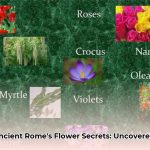Step back in time to ancient Rome, a civilization where grandeur and practicality intertwined, profoundly shaping the landscape of daily life. For many, the very idea of flowers in ancient Rome conjures images of opulent villas blooming with exotic flora and meticulously sculpted landscapes. Yet, what began as humble kitchen gardens, known as horti, providing essential sustenance, gradually blossomed into elaborate displays of wealth, cultural significance, and profound symbolic expression. These diverse green spaces, from the humblest backyard plot to the most extravagant imperial estate, tell a captivating story of Roman society, its evolving values, and its deep connection to the natural world. Learn more about Roman farming practices in this resource.
The Evolution of Roman Horticultural Splendor
The Roman Empire, thriving from approximately 150 BCE to 350 CE, offers a captivating glimpse into how flowers and plants were integrated into daily life and culture. Archaeological discoveries, particularly in the remarkably preserved cities of Pompeii and Herculaneum, alongside ancient texts and artwork, illuminate the dynamic interplay between practical function and aesthetic beauty. Cato the Elder, a revered Roman statesman, underscored the importance of garden placement in his seminal work De agri cultura, advocating for proximity to the home and the inclusion of both utilitarian and decorative plants. While the everyday Roman initially cultivated herbs and vegetables primarily for survival, the elite envisioned and crafted lavish villa gardens, designed for leisure, entertainment, and a striking demonstration of their affluence. This fundamental difference in garden types often mirrored the social standing of their owners, creating a visual hierarchy within the urban and rural landscapes.
Echoes of Distant Lands in Roman Gardens
Ancient Roman gardening practices were profoundly influenced by the advanced civilizations they encountered and absorbed. Persian gardens, celebrated for their intricate use of water and organized around flowing rills, notably inspired the sophisticated fountains and pools that became hallmarks of Roman designs, a technique believed to have been transmitted through Greek acquaintance. The expansive conquests of Alexander the Great introduced a wealth of new varieties of fruits and plants, sparking a wave of horticultural innovation across the Roman world. Even the formal garden layouts of Egypt, meticulously developed as early as 2800 BCE, with their elegant porticos seamlessly blending indoor and outdoor spaces, left their distinct mark. Adaptations of the Grecian model, most notably the peristyle garden—a colonnaded courtyard that connected homes to the outdoors—became a central feature in Roman homes. This architectural and horticultural innovation fostered a soothing connection between domestic spaces and the natural environment, transforming the central courtyard into an ornamental space for relaxation and entertaining. This rich tapestry of influences showcases the Romans’ remarkable ability to absorb, adapt, and dramatically enhance the practices of other societies.
The Social Tapestry of Roman Gardens: From Horti to Imperial Grandeur
The sheer variety of Roman gardens directly reflected the diverse needs and social strata of the empire, showcasing how architectural and landscape innovation catered to incredibly diverse needs, effortlessly harmonizing public grandeur with private comfort. The distinction was evident in every stone and every plant. What defined these vastly different dwellings, from the bustling communal insulae to the stately domus and the expansive country villas? Each type meticulously shaped the lives and reinforced the social status of its inhabitants.
Contrasting Abodes and Their Green Spaces
Imagine a vibrant, teeming Rome, where the insulae (multi-story apartment buildings) provided modest homes for the lower and middle classes. These structures, often hastily constructed, served as the Roman approximation of modern apartment complexes, with inhabitants sometimes making do with window boxes or rooftop plants. In stark contrast, the domus (single-family homes) were the private residences of the wealthy elite. These homes typically featured an inner courtyard, elaborate decorative frescoes, and spaces meticulously designed for both intimate family life and grand public receptions.
- Domus Gardens and the Peristyle: Common in urban dwellings like those found within the walls of Pompeii, these gardens often started as a simple hortus at the very back of the house, primarily for growing vegetables and herbs. With the advent of the Hellenistic peristyle, this central courtyard transformed into an ornamental space. Peristyle gardens consisted of formal flower beds, often edged with small shrubs or box hedges, surrounded by pathways. Water features and garden statues, along with small shrines (frequently depicting deities like Priapus and Dionysus), mingled amongst the plants to form visual focal points, designed to intrigue and entertain guests. Small garden rooms or exedras often opened out onto the garden, serving as entertaining and dining spaces. When space was at a premium, frescoes painted on the surrounding walls would extend the illusion of garden space, featuring trees and fountains or even giving the impression of overlooking the countryside or sea, as seen in the House of the Marine Venus in Pompeii. Examples like the House of the Surgeon in Pompeii showcase early horti, while the House of Octavius Quartio demonstrates a grander urban peristyle, taking up more ground space than the house itself.
At the pinnacle of Roman residential architecture were the villas—sprawling country estates owned by the super-rich. These were far more than just homes; they functioned as centers of agricultural production, luxurious leisure, and significant social power, frequently boasting multiple gardens.
Villa Gardens: Typically country houses for wealthy individuals, villas served as retreats from urban living. They are categorized by location: maritime, suburban, and country villas being the most common. Pliny the Younger describes his maritime villa at Laurentum at length, highlighting the lavish decoration, private exercise spaces (gymnasiums), and larger open areas for hunting game. Ornamental villa gardens were larger versions of the townhouse peristyle, with elaborately arranged flower beds, often on raised terraces, contained within colonnades with hedges, trees, and water features. Many had self-contained garden buildings like the pergola in the Garden of the House of Diomedes in Pompeii. These gardens also showcased topiary, an art inherited from the Greeks, shaping box hedges into various forms and animals, leading to the development of a specialized gardener class, the topiarius. Extensive estates also accommodated active exercise, such as riding grounds or ambulationes (tree-lined pathways), as described in Pliny’s Tuscan estate, often edged with yew, box, or trellises of vines. The swimming pool of the Villa Poppaea, set in a vast garden, further exemplifies the integration of exercise and leisure. Even these grand country gardens maintained an olera or vegetable patch, evolving to include hothouses for forcing grapes and melons by the first century AD.
Villa Rustica: These were villas set in the countryside, often the hub of large agricultural estates. Gardens at these sites were planted at a large scale and frequently found with processing equipment, indicating production for profit. These gardens could be technologically complex, incorporating advanced irrigation, grafts, and cross-pollination. Villa Boscoreale in Herculaneum is a notable example where extensive pollen analysis has been conducted to identify cultivated flora.
Imperial Gardens: Reserved exclusively for imperial families, these were exceptionally large and extravagant. Palace gardens within cities transformed with shifts in power, while imperial villa gardens mirrored typical country villas, albeit on a far more elaborate scale, designed to showcase immense power and wealth.
Non-Residential Gardens: This category encompasses gardens planted and maintained for public use or those dedicated to the people after the owner’s death. These included temple gardens, sacred groves (collections of trees honoring specific deities), parks, and commercial gardens specializing in produce or flowers. Non-residential gardens were constructed and dedicated to the public by the elite, often attached to other public buildings like theaters or baths in a practice known as euergetism.
By closely examining the contrasting architectural styles and the distinct social functions of insulae, domus, and villas, we gain a profound appreciation for the intricate social dynamics that fundamentally shaped ancient Roman society. It powerfully highlights the enduring impact of class distinctions on the built environment and, indeed, the very nature of their gardens. While the horti remained practical, the villa gardens became statements of power and artistry.
The Eloquent Language of Roman Flora: Symbolism and Significance
Beyond their visual allure, flowers in ancient Rome and other plants were imbued with deep, often sacred, symbolism. Gardens were not merely collections of plants; they were living narratives, conveying messages and honoring deities. The strategic presence of sacred plants within the Roman Forum itself further underscores their importance. Fig, olive, and vine trees were meticulously maintained, their health reflecting the community’s well-being; their wilting was interpreted as a dire omen, immediately replaced to ward off prophesied misfortune. This symbolic depth highlights how deeply intertwined nature and cultural beliefs were in Roman daily life.
Let us explore the profound meanings attributed to specific plants:
Ficus Ruminalis (Wild Fig Tree): This tree held immense religious and mythological significance, sacred to Rumina, who protected breastfeeding in humans and animals. It’s closely connected to the legend of Romulus and Remus, said to have stood on the banks of the Tiber where their makeshift cradle came to rest, providing shade as they were suckled by a she-wolf near the Lupercal cave. A statue of the she-wolf often stood beside it. Later, the Ficus Navia, miraculously transplanted by the augur Attus Navius to the Comitium, replaced the original symbolism. Its wilting was a bad omen for Rome, and its miraculous revival in 58 AD was a sign of hope.
Laurus nobilis (Laurel): Highly revered, the laurel was sacred to Apollo, symbolizing wisdom, victory, honor, and glory. Winners of the Pythian Games received laurel wreaths, a tradition that crowned victorious emperors and poets, a practice still echoed in academic honors today. Augustus’s house on Palatine Hill featured two laurel trees, linking him to Apollo. Empress Livia’s planting of a laurel sprig at Prima Porta, from which a grove grew, tied the plant to the Julio-Claudian dynasty; its death during Nero’s reign was considered an omen of the dynasty’s end. Tiberius wore laurel wreaths for protection during storms, as the plant was believed immune to lightning, owing to its crackling sound when burning, interpreted as a “heavenly fire demon.” Laurel also possessed powers of divination; Apollo’s priestess, the Pythia, chewed its leaves before prophecies.
Mentha (Mint): In Greek mythology, the Naiad nymph Minthe was transformed into the fragrant mint plant by a jealous Persephone, Hades’ wife, or by Demeter after Minthe boasted Hades would return to her. Mint was used in funerary rituals to mask decay and was a key ingredient in kykeon, a sacred barley drink consumed during the Eleusinian Mysteries, promising hope for the afterlife. Valued for its fragrance and flavor, it was also considered an aphrodisiac, yet paradoxically believed to have contraceptive properties, linking it to barrenness and opposing Demeter, goddess of fertility. Seneca advised soldiers against consuming it, believing it reduced energy, while in magic, it was used to calm emotions and connect with deceased loved ones.
Myrtus communis (Myrtle): Known for medicinal properties since 600 BCE, myrtle symbolized honor, justice, prosperity, generosity, hope, love, and happiness. Sacred to Aphrodite and Demeter, it was a good luck symbol for farmers and women. Myrtle wreaths encircled heads before long journeys or settling in new colonies, symbolizing hopes for success. Used in wedding rituals, it symbolized fertility and fruitfulness, earning the name “Myrtus coniugalis” for happy marriages. In mythology, myrtle fronds were said to purify and reconcile Romans and Sabines. Associated with Venus, it was worn by women during the Veneralia festival. In Virgil’s Aeneid, myrtle marked Polydorus’s grave, bleeding when disturbed. It also held significant funerary meaning, representing the underworld and the dead, as Dionysus had to leave a myrtle plant to visit the underworld. In magic, it appeased the dead and offered protection during risky ventures.
Oak: Revered by Greeks (sacred to Zeus at Dodona) and Romans (dedicated to Jupiter), the oak symbolized virtue, strength, courage, dignity, and perseverance, seen as a good omen. The Civic Crown (corona civica), the second-highest civilian honor in the Roman Republic and Empire, was a chaplet of oak leaves awarded for saving fellow citizens’ lives in battle.
Olea europaea (Olive Tree): Holding a significant place in Mediterranean civilizations, the olive tree was sacred to the Greeks, with legends of Athena planting her spear to grow an olive branch as a blessing. Homer mentions it in the Iliad and Odyssey. Pliny the Elder notes its arrival in Rome during Tarquinius Priscus’s reign (581 BCE). Beyond its oil for cooking (preferred over butter or pork fat) and lamps (in homes and temples), the olive tree symbolized longevity, endurance, peace (associated with the goddess Pax), and survival due to its drought/cold resistance and ability to rejuvenate from a cut trunk.
Phoenix dactylifera (Date Palm): Palm fronds were frequently carried in triumphal processions as a representation of victory, so strongly linked that “palma” became a metonym for victory itself. Palm leaves adorned doorways of victorious attorneys. A palm tree mysteriously appearing in the Temple of Nike in










